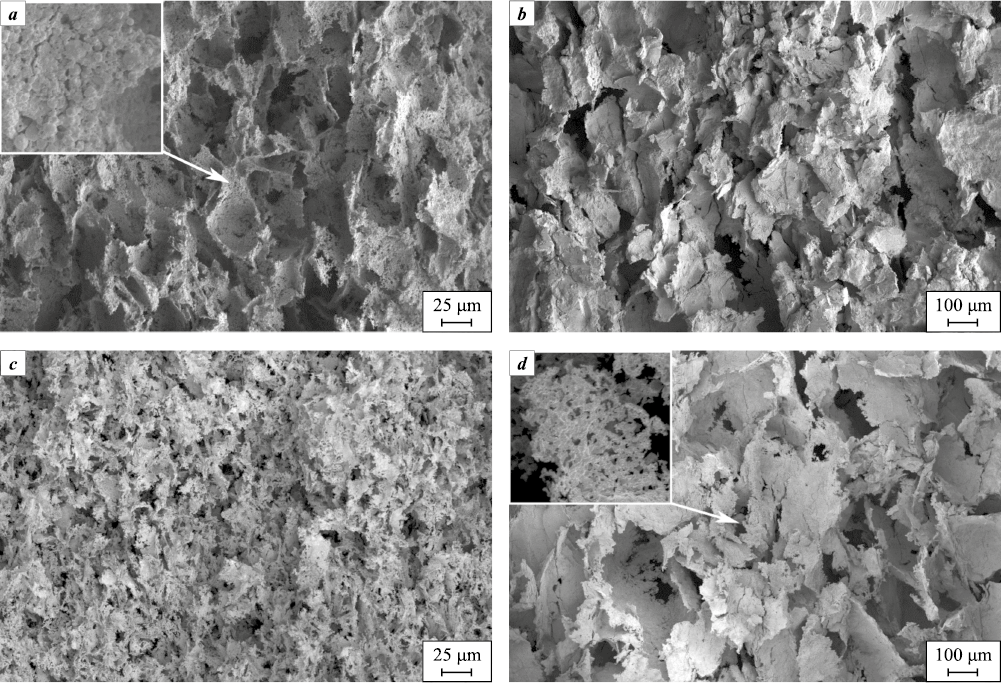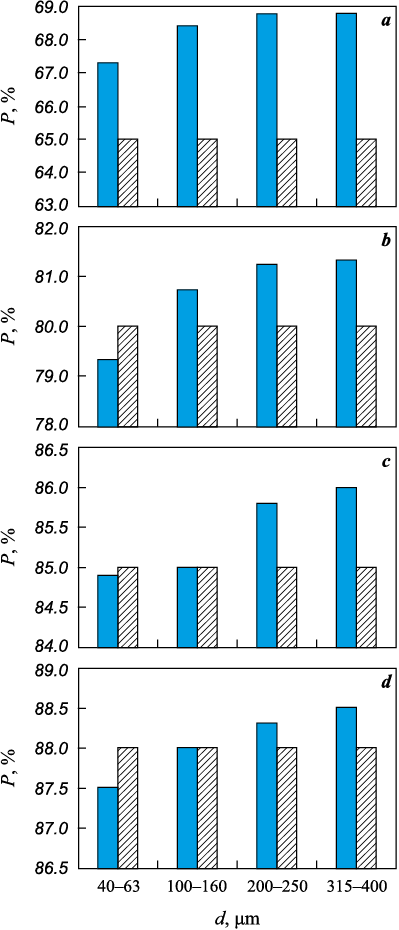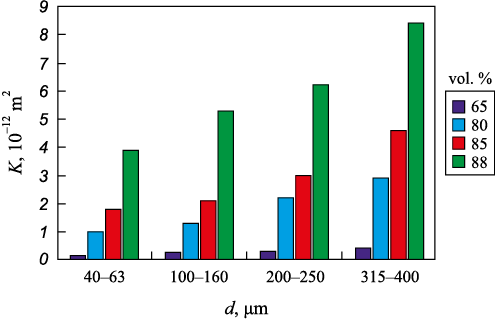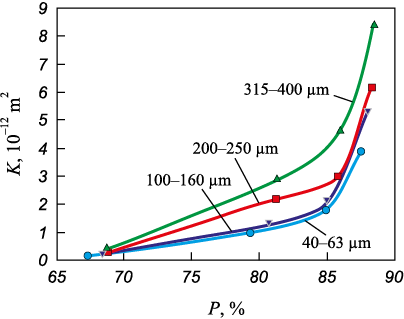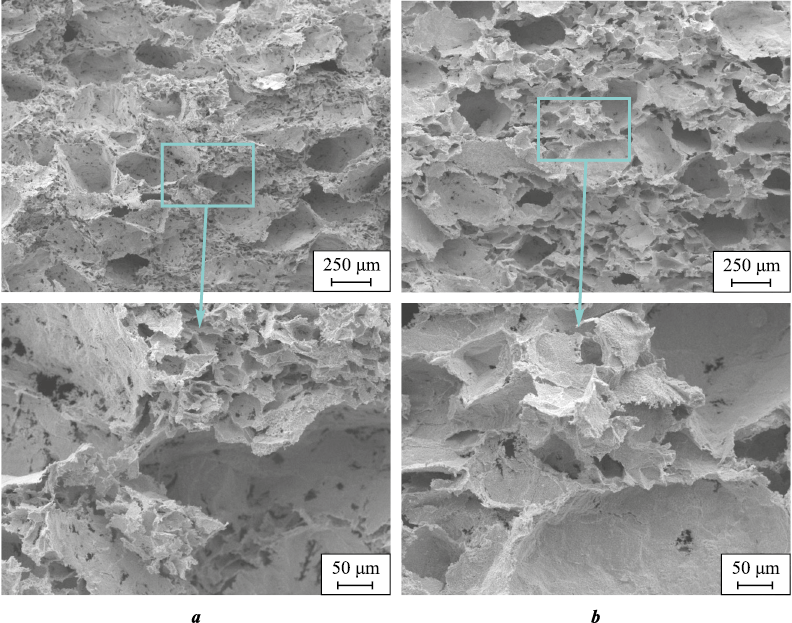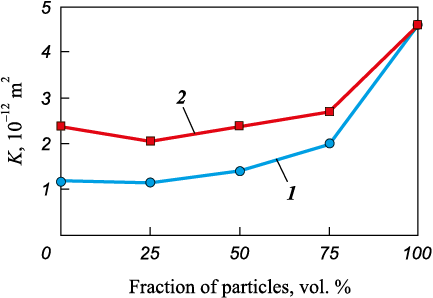Scroll to:
The influence of porogen dispersion on the structure and permeability of highly porous material from nickel nanopowder
https://doi.org/10.17073/1997-308X-2024-6-56-64
Abstract
The study investigates the structure, porosity, and permeability of highly porous materials based on nickel nanopowders, which were synthesized using ammonium carbonate as a porogen. The process of sample fabrication involves three technological steps: preparation of the initial mixtures of metal nanopowder with a porogen, compaction of the green samples, and subsequent sintering. The average particle size of the nickel powder was less than 100 nm. Ammonium carbonate powders with particle sizes of 40–63, 100–160, 200–250, and 315–400 µm, obtained by sieving, were selected for the experiments. The porogen’s volume fraction in the initial mixtures with nickel nanopowder was 60, 80, 85, and 88 %, with a compaction pressure of 300 MPa. The stages of sintering the nickel nanopowder were preceded by the removal of ammonium carbonate from the green sample by heating it in an argon flow to 100 °C at a rate not exceeding 1 °C/min. The optimal sintering temperature and time for the nickel nanopowder were determined to be 550 °C for 120 min. The research aimed to establish the influence of the porogen’s particle size, its size distribution, and volume fraction on the material’s porosity and permeability. The results showed that increasing the particle size and volume fraction of the porogen leads to higher porosity and permeability of the material. The maximum permeability value achieved was 8.4·10–12 m2 from a sample with 88.5 % porosity, produced using a porogen with a particle size of 315–400 µm. When using porogen powders with two different particle size ranges: 40–50 µm and 315–400 µm (or 100–125 µm and 315–400 µm), the permeability was limited to values obtained from samples using only one of these fractions. In this case, the permeability changed nonlinearly depending on the ratio of each fraction component.
For citations:
Shustov V.S., Zelensky V.A., Alymov M.I., Ankudinov A.B., Ustyukhin A.S. The influence of porogen dispersion on the structure and permeability of highly porous material from nickel nanopowder. Powder Metallurgy аnd Functional Coatings (Izvestiya Vuzov. Poroshkovaya Metallurgiya i Funktsional'nye Pokrytiya). 2024;18(6):56-64. https://doi.org/10.17073/1997-308X-2024-6-56-64
Introduction
Porous materials are used in many industries. The porous structure, typically regarded as a defect in structural materials, provides unique properties that can be utilized for specific purposes [1]. Highly porous materials can be effectively used as electrodes [2], filters that separate impurity particles larger than the pore size [3–5], and are often employed as thermal insulators [6; 7]. Another application of porous materials is in biocompatible implants [8]. The relatively high internal surface area makes highly porous materials excellent catalysts [9; 10].
Depending on the specific application and the required porous structure, various fabrication methods can be employed to produce such materials, including partial sintering, the use of temporary porogens, direct foaming, and others. In the first case, the powder material is sintered in such a way that pores remain between the particles [11; 12]. This is due either to too low temperature and duration of sintering or to the low density of the initial green sample. In the second method, the added porogens decompose into volatile components or are washed out of the material during its production. The porous structure is controlled by appropriately selecting the porogenic substances. For porous materials produced using dispersed porogens, the shape and size of the pores depend on the shape and size of the porogen particles, while porosity is controlled by the quantitative content of the porogen [13]. This methodology allows for higher porosity values compared to the partial sintering technique. The approaches applied to the fabrication of highly porous materials from powders of various natures with the addition of temporary porogens are seen by the authors as promising, as they enable wide-ranging control over porosity and pore size in the resulting material.
It is important to note that simply having a highly porous structure is insufficient for certain applications. For filters and catalysts, it is necessary to create a porous material with a high proportion of open interconnected pores. This ensures good permeability, an important property for ensuring the reliable operation of the products in which they are used. Permeability is defined as the coefficient that relates the pressure gradient to the flow rate of the medium passing through the sample. It depends on the porous structure and can vary sharply with changes in the pore size distribution or the spatial arrangement and shape of the pore channels [10; 14–17]. It should be noted that a high porosity value does not always indicate good permeability.
In many studies where the authors create a porous material and investigate its structure, insufficient attention is paid to this parameter. However, some researchers provide permeability data without a thorough analysis of their relationship with the morphology of the porous space. Most studies focusing on permeability examine the flow of media through porous structures governed by Darcy’s law or Forchheimer’s law [18–25]. These laws are phenomenological and do not contain any condition describing the influence of the material’s microstructure. Therefore, researchers face the pressing task of finding ways to accurately assess permeability based on models developed considering the material’s microstructure parameters and allowing for predictions of permeability levels [26; 27]. Existing models do not fully account for all the features of the porous structures of modern materials, and creating new models requires a significant amount of experimental data on the relationship between permeability and various structural characteristics. Consequently, to better understand the processes, experimental studies are necessary to identify the connection between the structural features of the porous material and its permeability.
The aim of this work was to establish the influence of the porogen particle size and its volume fraction on the porosity and permeability of the nickel nanopowder material produced through pressing and sintering.
Research methodology
Nickel nanopowder with an average particle size of less than 100 nm, produced by wire explosion technology, was used as the starting material for the production of porous samples. This powder contained a small amount of larger spherical particles, up to 3 µm in size, which is a characteristic and drawback of this method for obtaining nanopowders. Ammonium carbonate (NH4)2CO3 powders were used as the porogen. To study the influence of the volume fraction and dispersion of the porogen on the structure and permeability, ammonium carbonate powders with particle sizes of d = 40÷63, 100÷160, 200÷250, and 315÷400 µm were selected.
To determine the effect of the particle size distribution of the porogen on the structure and permeability, additional mixtures of the porogen were prepared, using particles from two size ranges: 40–50 and 315–400 µm, as well as 100–125 and 315–400 µm. For simplicity, these porogen powders will hereafter be referred to as “bidisperse”. In each mixture, the amounts of both fractions of the powders were varied in steps of 25 % – from 100 % content of the powder with d = 40÷50 µm (or 100÷125 µm) to 100 % content of the powder with d = 315÷400 µm.
The production of porous nickel materials consisted of three technological operations: preparing the initial mixtures of nickel nanopowder with the porogen, compacting the green samples, and sintering them. The volume fraction of the porogen in the initial mixtures was 60, 80, 85, and 88 %, with a compaction pressure of 300 MPa. The samples were produced by uniaxial compaction on a hydraulic press (Knuth, Germany) in a split mold with a diameter of 13.6 mm. The height of the compacts before sintering was 10 mm. To remove ammonium carbonate, the compacts were heated in an argon flow to a temperature of 100 °C at a rate not exceeding 1 °C/min. The optimal sintering temperature for the nickel nanopowder was determined to be 550 °C, with a sintering time of 120 min. The heating rate to the sintering temperature did not exceed 2 °C/min, which was necessary for the slow removal of the decomposition products of the porogen. Higher heating rates resulted in structural defects in the samples, such as microcracks. The thermal treatment of the samples was conducted in a tube furnace (MTI GSL1500X, USA).
Porosity was measured using the hydrostatic weighing method, with a relative error not exceeding 0.6 %. The permeability of the obtained porous nickel samples was determined using a method based on Darcy’s law. For this, while a liquid flowed through the sample, the pressure drop across its ends and the flow rate of the liquid – determined by the known volume of liquid passing through the sample over a fixed period – were recorded. The study was conducted by passing distilled water under pressure at room temperature. The pressure drop across the tested samples varied from 0 to 0.02 MPa, with the value recorded using a digital manometer (DM5002M, Manotomy JSC, Russia) with an allowable measurement error of 2·10–5 MPa. The relative error in the permeability measurement did not exceed 10 %.
Results and discussion
Fig. 1 presents the microstructure of the fracture surfaces of samples with porosities of 79.3 and 88.5 %, sintered in a hydrogen atmosphere at a temperature of 550 °C. The volume fraction of the porogen in the mixture from which these samples were pressed was 80 and 88 %, respectively. Scanning electron microscopy revealed that, due to the thermal decomposition of the porogen, a pore structure was formed, which can be considered a replica of the removed porogen, with some modification in their shape and size as a result of compaction and sintering. Due to the high activity of the nanopowders, sintering was conducted at a relatively low temperature, resulting in samples with sufficient strength necessary for further investigation of their permeability.
Fig. 1. SEM images of the fracture of nickel nanopowder samples obtained using a porogen |
In samples with an initial porogen content of 88 %, a significant number of thin walls, with a thickness of no more than 1–3 µm, were observed, featuring “windows” formed at the points of contact between porogen particles as well as from the escape of decomposition products. The small amount of nickel powder present in the framework of the highly porous material apparently defined a “lace-like” structure in these walls, characterized by numerous smaller holes or voids compared to the windows. Moreover, the smaller the porogen used, the more pronounced this structure became.
The influence of the volume fraction of the porogen and its dispersion on the porosity (P) and permeability (K) of the sintered material was investigated. Fig. 2 presents the dependencies of the porosity of the sintered material on the particle size (d) of the porogen for samples in which the volume fraction of the porogen was 65, 80, 85, and 88 %. It is evident that the value of P increases with increasing values of d. When using a porogen with d > 100 µm, the porosity of the sintered material equals or exceeds the expected value, which is equal to the volume fraction of the porogen in the initial mixture. For d = 40÷63 µm, the value of P was lower than expected, except for samples with a porogen volume fraction of 65 %. The closed porosity of all materials did not exceed 1 %. The porogen (NH4)2CO3 decomposes during sintering at temperatures below 100 °C. This leads to the release of pore space and the formation of channels that connect the pores to the free surface of the sample. The interconnection of pores in such materials determines the high proportion of open porosity and their permeability.
Fig. 2. Diagrams showing the dependence of the porosity of the sintered material |
The dependence of permeability on the volume fraction of the porogen and its dispersion was investigated (Fig. 3). It was found that as the volume fraction of the porogen increases, the permeability also rises. Additionally, this increase is achieved through the enlargement of the porogen particle size while maintaining a constant volume fraction in the initial powder mixture. For example, with a porogen content of 65 vol. %, the permeability (K, 10–12) increases from 0.1 to 0.4 m2, at 80 vol. %, it rises from 1 to 2.9 m2, at 85 vol. %, from 1.8 to 4.6 m2, and at 88 vol. %, from 3.9 to 8.4 m2.
Fig. 3. Diagram showing the dependence of the permeability of the nickel |
Fig. 4 illustrates the dependence of permeability on the porosity of the material for samples obtained using porogen powder with particles of a specified size range.
Fig. 4. Graph showing the dependence of the material’s permeability |
Using the compaction and sintering regimes described above, samples were obtained from mixtures of nickel nanopowder and bidisperse porogen, with the latter fixed at 85 vol. %. Data from Fig. 5 show that the samples contain pores corresponding to the sizes of the particles of the porogen used – large pores from particles with diameters of 315–400 µm and small pores from particles with diameters of 40–50 µm or 100–125 µm (Fig. 5, a, b). No inhomogeneity in the pore distribution within the volume of the samples was detected.
Fig. 5. SEM images of the fracture of porous nickel nanopowder samples obtained using a bidisperse porogen with particle sizes of 40–50 and 315–400 μm (a), and 100–125 and 315–400 μm (b) |
It is noteworthy that in samples containing the porogen with smaller particle sizes (40–50 µm), there was a greater number of windows on the surfaces of the larger pores. These windows are comparable in size to the smaller porogen particles and were likely formed due to their contact with the larger ones. It can be hypothesized that a greater number of windows will provide better permeability in this series of samples, along with the high permeability achieved by using porogen with particle sizes of 315–400 µm. However, according to the results of the study (Fig. 6), the samples obtained from mixtures with smaller porogen particles (40–50 µm) exhibited lower permeability compared to those using powders with diameters of 100–125 µm. The content of larger porogen particles (315–400 µm) ranging from 0 to 50 % did not lead to a significant change in the value of K: for samples made with porogen of 40–50 µm, the permeability was (1.3±0.1)·10–12 m2, while with 100–125 µm it was (2.2±0.2)·10–12 m2. Further increasing the proportion of 315–400 µm particles in the porogen resulted in an increase in K to 4.6·10–12 m2.
Fig. 6. Dependence of the permeability of samples obtained using a bidisperse porogen |
Conclusions
As a result of the conducted studies on the structure and permeability of the obtained porous materials, the following conclusions were established.
1. The permeability of highly porous materials made from nickel nanopowders increases with both the volume fraction of the porogen, ranging from 60 to 88 %, and the particle size of the porogen. The maximum permeability achieved was 8.4·10–12 m2 in a sample with a porosity of 88.5 %.
2. Using a bidisperse porogen facilitates smoother regulation of the permeability in nickel nanopowder materials. As the proportion of larger particles (315–400 µm) in the porogen powder increases, the samples exhibit enhanced permeability. The lowest permeability was recorded when only fine porogen was used (e.g., with particle sizes of 40–50 µm or 100–125 µm). When up to 50 vol. % of larger particles is added, the permeability varies by approximately 10 %. A notable increase in permeability, reaching 4.6·10–12 m2, is observed at a 100 % volume fraction of porogen particles sized 315–400 µm in the initial mixture.
References
1. Lefebvre L., Banhart J., Dunand D.C. Porous metals and metallic foams: Current status and recent developments. Advanced Engineering Materials. 2008;10(9):775–787. https://doi.org/10.1002/adem.200800241
2. Chen H., Hu L., Chen M., Yan Y., Wu L. Nickel-cobalt layered double hydroxide nanosheets for high – performance supercapacitor electrode materials. Advanced Functional Materials. 2014;24(7):934–942. https://doi.org/10.1002/adfm.201301747
3. Maggay I.V., Chang Y., Venault A., Dizon G.V., Wu C.J. Functionalized porous filtration media for gravity-driven filtration: Reviewing a new emerging approach for oil and water emulsions separation. Separation and Purification Technology. 2021;259:117983. https://doi.org/10.1016/j.seppur.2020.117983
4. Mazurkow J.M., Yüzbasi N.S., Domagala K.W., Pfeiffer S., Kata D., Graule T. Nano-sized copper (oxide) on alumina granules for water filtration: effect of copper oxidation state on virus removal performance. Environmental Science & Technology. 2019;54(2):1214–1222. https://doi.org/10.1021/acs.est.9b05211
5. Hellmann A., Pitz M., Schmidt K., Haller F., Ripperger S. Characterization of an open-pored nickel foam with respect to aerosol filtration efficiency by means of measurement and simulation. Aerosol Science and Technology. 2015;49(1):16–23. https://doi.org/10.1080/02786826.2014.990555
6. Qiu L., Zou H., Tang D., Wen D., Feng Y., Zhang X. Inhomogeneity in pore size appreciably lowering thermal conductivity for porous thermal insulators. Applied Thermal Engineering. 2018;130:1004–1011. https://doi.org/10.1016/J.APPLTHERMALENG.2017.11.066
7. Jia C., Li L., Liu Y., Fang B., Ding H., Song J., Liu Y., Xiang K., Lin S., Li Z., Si W., Li B., Sheng X., Wang D., Wei X., Wu H. Highly compressible and anisotropic lamellar ceramic sponges with superior thermal insulation and acoustic absorption performances. Nature Communications. 2020;11(1):1–13. https://doi.org/10.1038/s41467-020-17533-6
8. Szlązak K., Jaroszewicz J., Ostrowska B., Jaroszewicz T., Nabiałek M., Szota M., Swieszkowski W. Characterization of three-dimensional printed composite scaffolds prepared with different fabrication methods. Archives of Metallurgy and Materials. 2016;61(2A):645–650. https://doi.org/10.1515/amm-2016-0110
9. Yang C., Zhang C., Chen Z. J., Li Y., Yan W.Y., Yu H.B., Liu L. Three-dimensional hierarchical porous structures of metallic glass/copper composite catalysts by 3D printing for efficient wastewater treatments. ACS Applied Materials & Interfaces. 2021;13(6):7227–7237. https://doi.org/10.1021/acsami.0c20832
10. Ibrahim S.H., Skibinski J., Oliver G.J., Wejrzanowski T. Microstructure effect on the permeability of the tape-cast open-porous materials. Materials and Design. 2019;167:1–7. https://doi.org/10.1016/j.matdes.2019.107639
11. Ohji T., Fukushima M. Macro-porous ceramics: processing and properties macro-porous ceramics: processing and properties. International Materials Reviews. 2013;57(2):115–131. https://doi.org/10.1179/1743280411Y.0000000006
12. Lyckfeldt O., Ferreira J.M.F. Processing of porous ceramics by ‘starch consolidation’. Journal of the European Ceramic Society. 1998;18(2):131–140. https://doi.org/10.1016/S0955-2219(97)00101-5
13. Li Y., Yang X., Liu D., Chen J., Zhang D., Wu Z. Permeability of the porous Al2O3 ceramic with bimodal pore size distribution. Ceramics International. 2019;45(5):5952–5957. https://doi.org/10.1016/j.ceramint.2018.12.064
14. Lv C., Li W., Du J., Liang J., Yang H., Zhu Y., Ma B. Experimental investigation of permeability and Darcy-Forchheimer flow transition in metal foam with high pore density. Experimental Thermal and Fluid Science. 2024;154:111149. https://doi.org/10.1016/j.expthermflusci.2024.111149
15. Afsharpoor A., Javadpour F. Liquid slip flow in a network of shale noncircular nanopores. Fuel. 2016;180:580–590. https://doi.org/10.1016/j.fuel.2016.04.078
16. Xu X., Liu X., Wu J., Zhang C., Tian K., Yu J. Effect of preparation conditions on gas permeability parameters of porous SiC ceramics. Journal of the European Ceramic Society. 2021;41(6):3252–3263. https://doi.org/10.1016/j.jeurceramsoc.2021.01.015
17. Dai Q., Wang G., Zhao X., Han Z., Lu K., Lai J., Wang S., Li D., Li Y., Wu K. Fractal model for permeability estimation in low-permeable porous media with variable pore sizes and unevenly adsorbed water lay. Marine and Petroleum Geology. 2021;130:105135. https://doi.org/10.1016/j.marpetgeo.2021.105135
18. Dukhan N., Bağcı Ö., Özdemir M. Metal foam hydrodynamics: Flow regimes from pre-Darcy to turbulent. International Journal of Heat and Mass Transfer. 2014;77:114–123. https://doi.org/10.1016/j.ijheatmasstransfer.2014.05.017
19. Belyaev E.S., Khlybov A.A., Matsulevich Z.V., Titov E.Y., Getmanovsky Y.A., Belyaeva S. S., Bystrov E.O., Ryabov D.A., Kovylin R.S., Tchesnokov S.A., Bazanov A.V., Mezhevoi I.N., Baykov V.E., Yunin V.V. Micromechanics of porosity of various degrees in porous permeable Ti–V30 getter made of powder. Vacuum. 2023;211:111934. https://doi.org/10.1016/j.vacuum.2023.111934
20. Tang H.P., Wang J., Qian M. 28-Porous titanium structures and applications. In: Titanium Powder Metallurgy. Ed. Ma Qian, Francis H. (Sam) Froes, Butterworth-Heinemann, 2015. P. 533–554. https://doi.org/10.1016/B978-0-12-800054-0.00028-9
21. Xie D., Dittmeyer R. Correlations of laser scanning parameters and porous structure properties of permeable materials made by laser-beam powder-bed fusion. Additive Manufacturing. 2021;47:102261. https://doi.org/10.1016/j.addma.2021.102261
22. Lupo M., Neveu A., Gemine T., Francqui F., Lumay G. Measuring permeability and flowability of powders at various packing fractions. Particuology. 2024. https://doi.org/10.1016/j.partic.2024.03.008
23. Xu Y., Zhang S., Ding W., Du H., Li M., Li Z., Chen M. Additively-manufactured gradient porous bio-scaffolds: Permeability, cytocompatibility and mechanical properties. Composite Structures. 2024;336:118021. https://doi.org/10.1016/j.compstruct.2024.118021
24. Li C., Zhou Z. Preparation and characterization of permeability and mechanical properties of three-dimensional porous stainless steel. RSC Advances. 2022;12(43): 28079–28087. https://doi.org/10.1039/D2RA03893E
25. Sauermoser-Yri M., Veldurthi N., Wölfle C.H., Svartvatn P.J., Hoem S.O.F., Lid M.J., Bock R., Palko J.W., Torgersen J. On the porosity-dependent permeability and conductivity of triply periodic minimal surface based porous media. Journal of Materials Research and Technology. 2023;27:585–599. https://doi.org/10.1016/j.jmrt.2023.09.242
26. Otaru A.J., Auta M. Machine learning backpropagation network analysis of permeability, Forchheimer coefficient, and effective thermal conductivity of macroporous foam–fluid systems. International Journal of Thermal Sciences. 2024;201:109039. https://doi.org/10.1016/j.ijthermalsci.2024.109039
27. Song S., Rong L., Dong K., Liu X., Le-Clech P., Shen Y. Pore-scale numerical study of intrinsic permeability for fluid flow through asymmetric ceramic microfiltration membranes. Journal of Membrane Science. 2022;642: 119920. https://doi.org/10.1016/j.memsci.2021.119920
About the Authors
V. S. ShustovRussian Federation
Vadim S. Shustov – Cand. Sci. (Eng.), Senior Research Scientist at the Laboratory of Physical Chemistry of Surfaces and Ultrafine Powder Materials
49 Leninskiy Prosp., Moscow 119334, Russia
V. A. Zelensky
Russian Federation
Viktor A. Zelensky – Cand. Sci. (Phys.-Math.), Leading Researcher at the Laboratory of Physical Chemistry of Surfaces and Ultrafine Powder Materials
49 Leninskiy Prosp., Moscow 119334, Russia
M. I. Alymov
Russian Federation
Mikhail I. Alymov – Dr. Sci. (Eng.), Corresponding Member of RAS, Head of the Laboratory of Physical Chemistry of Surfaces and Ultrafine Powder Materials
49 Leninskiy Prosp., Moscow 119334, Russia
A. B. Ankudinov
Russian Federation
Alexey B. Ankudinov – Senior Research Scientist at the Laboratory of Physical Chemistry of Surfaces and Ultrafine Powder Materials
49 Leninskiy Prosp., Moscow 119334, Russia
A. S. Ustyukhin
Russian Federation
Alexey S. Ustyukhin – Cand. Sci. (Eng.), Junior Research Scientist at the Laboratory of Physical Chemistry of Surfaces and Ultrafine Powder Materials
49 Leninskiy Prosp., Moscow 119334, Russia
Review
For citations:
Shustov V.S., Zelensky V.A., Alymov M.I., Ankudinov A.B., Ustyukhin A.S. The influence of porogen dispersion on the structure and permeability of highly porous material from nickel nanopowder. Powder Metallurgy аnd Functional Coatings (Izvestiya Vuzov. Poroshkovaya Metallurgiya i Funktsional'nye Pokrytiya). 2024;18(6):56-64. https://doi.org/10.17073/1997-308X-2024-6-56-64




